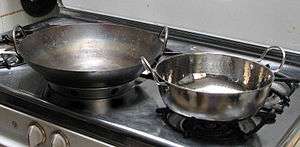Karahi
A karahi (/kəˈraɪ/; Hindi: कड़ाही kaṛāhī, Urdu: کڑاہی; also kadai, korai, karai, kadhi, kadahi, kadhai or cheena chatti) is a type of thick, circular, and deep cooking-pot[1] (similar in shape to a wok) used in Indian, Pakistani, Bangladeshi, and Nepalese cuisine. Traditionally made out of cast iron, karahi look like woks with steeper sides. Today they can be made of stainless steel, copper, and non-stick surfaces, both round and flat-bottomed.
Use
Karahi serve for the shallow or deep frying of meat, potatoes, sweets, and snacks such as samosa and fish and also for Indian papadums, but are most noted for the simmering of stews or posola,[2][3] which are often named karahi dishes after the utensil.
Karahi dishes

_-_Karahi_Chicken.jpg)
Stews prepared in a karahi include chicken karahi, beef karahi, mutton karahi (usually made with goat meat, reflecting South Asian usage of the word mutton) and dumba karahi (made with lamb meat) and also karahi paneer (a vegetarian version). Prepared in a reduced tomato and green-chilli base, a karahi is a popular late-night meal in Pakistani cuisine, usually ordered by the kilogram and consumed with naan.
A balti, based on the food of Baltistan, is another dish cooked in a karahi.
An inverted karahi is used to cook Rumali Rotis.
References
- ↑ "Kadhai". Indianfood.about.com. 2009-09-25. Retrieved 2009-11-02.
- ↑ Promodini Varma, Dheeraj Paul Indian Menu Planner Introduction Roli Books Private Limited, 1995 ISBN 81-7437-018-8, ISBN 978-81-7437-018-1. 192 pages
- ↑ J. Inder Singh Kalra Prashad Cooking with Indian Masters page 28
External links
-
 Media related to Karahi at Wikimedia Commons
Media related to Karahi at Wikimedia Commons
